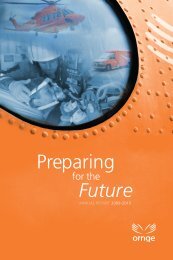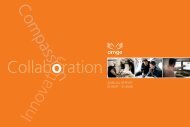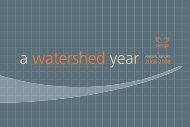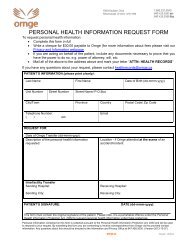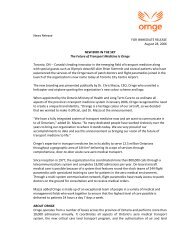Ornge Landing Zone Safety Procedures
Ornge Onscene Safety Procedures
Ornge Onscene Safety Procedures
- No tags were found...
You also want an ePaper? Increase the reach of your titles
YUMPU automatically turns print PDFs into web optimized ePapers that Google loves.
<strong>Ornge</strong> <strong>Landing</strong> <strong>Zone</strong> <strong>Safety</strong><br />
<strong>Procedures</strong><br />
Version 1 - 11/8/2010<br />
<strong>Ornge</strong> LZ <strong>Safety</strong><br />
page 1
<strong>Landing</strong> <strong>Zone</strong> Coordinator Role<br />
• Select a landing site coordinator:<br />
• someone who is not involved in scene operations or patient care,<br />
• police, firefighters, or other first responders are an excellent choice<br />
• The landing zone coordinator is responsible for selecting, setting up,<br />
securing and maintaining an area for the helicopter, throughout the entire<br />
transport operation<br />
• The landing zone coordinator must remain on site and fulfill these<br />
responsibilities from the time of the initial request, until the helicopter<br />
departs the scene<br />
• The Captain of the helicopter is responsible for utilizing the selected<br />
landing zone or choosing a more appropriate, safe alternative, and always<br />
has the final decision on whether or not to land<br />
Version 1 - 11/8/2010<br />
<strong>Ornge</strong> LZ <strong>Safety</strong><br />
page 2
• 150 feet x 150 feet Minimum<br />
• If multiple sites are available, choose the best and<br />
safest option for the helicopter and its crew<br />
• Where possible the landing zone must not be<br />
boxed in by emergency vehicles unless no other<br />
option is available<br />
• Clear of obstacles (wires, trees, stumps, vehicles),<br />
or loose debris<br />
• Stable surface (concrete, asphalt, packed gravel,<br />
grass)<br />
• As flat as possible<br />
• Do not use flares or other objects to outline the<br />
landing zone<br />
• Stretchers shall be left in the ambulance and all<br />
loose articles secured until directed by pilot or<br />
crew members<br />
• Fire fighters should not lay out hose, any hoses<br />
that have been laid must be charged<br />
Minimum <strong>Landing</strong> <strong>Zone</strong><br />
Requirements<br />
Version 1 - 11/8/2010<br />
<strong>Ornge</strong> LZ <strong>Safety</strong><br />
page 3
Securing the <strong>Landing</strong> <strong>Zone</strong><br />
• Place a minimum of two vehicles, beyond each end of the designated landing zone,<br />
perpendicular to the intended landing zone (i.e. road, clear section of field, etc). This<br />
is to prevent site access to other vehicles. Personnel should also be in place to<br />
prevent access to the landing zone<br />
• If the landing zone is dusty, have the fire department wet the area down to prevent a<br />
zero visibility situation when the helicopter lands<br />
• Fresh snow should be packed down to prevent whiteout conditions. If this is not<br />
practical, warn the aircrew of loose or powder snow conditions<br />
• Vehicles and personnel are strictly prohibited from the landing zone (radius of 150’)<br />
from a minimum of 3 minutes prior to the estimated time of arrival until there is<br />
positive and definitive indication from the flight crew it is safe to enter the landing<br />
zone<br />
• There shall be no vehicles or personnel within the landing zone at any time after an<br />
indication, verbal or physical from the flight crew that they are ready to start engines<br />
Version 1 - 11/8/2010<br />
<strong>Ornge</strong> LZ <strong>Safety</strong><br />
page 4
Communications<br />
• Determine an accurate description of the landing zone in relation to the scene<br />
location<br />
• GPS coordinates are the PREFERRED method of identifying the site and should<br />
be used conjunction with all other means<br />
• Include highway numbers and distances to nearby towns<br />
• Provide directional (compass) headings to the scene from the landmarks<br />
• Emergency service vehicle automatic vehicle locators (AVLs) can be used to<br />
provide the crew with coordinates of the accident area<br />
• All scene and landing zone location information should be relayed to local dispatch<br />
so it can be relayed to the <strong>Ornge</strong> Communications Centre and subsequently to the<br />
flight crew<br />
Version 1 - 11/8/2010<br />
<strong>Ornge</strong> LZ <strong>Safety</strong><br />
page 5
Dangerous Obstacles<br />
• The following obstacles within a 360 degree radius shall be relayed to the<br />
flight crew prior to landing:<br />
• Trees<br />
• Utility poles<br />
• Wires<br />
• Ditches<br />
• Signs<br />
• Any object that the helicopter could dislodge<br />
• Each obstacle should be identified to the pilot in relation to the landing<br />
zone, i.e. “There is a large light standard 30 feet west of the landing zone”<br />
• The two following slides will illustrate dangerous obstacles found at<br />
scenes<br />
Version 1 - 11/8/2010<br />
<strong>Ornge</strong> LZ <strong>Safety</strong><br />
page 6
On Scene Hazards<br />
Wires near LZ –<br />
Report to Flight Crew<br />
Ditch adjacent to LZ –<br />
Report to Flight Crew<br />
Road Signs near LZ -<br />
Report to Flight Crew<br />
Version 1 - 11/8/2010<br />
<strong>Ornge</strong> LZ <strong>Safety</strong><br />
page 7
Aerial View of Scene<br />
Large Sign –<br />
Report to Flight Crew<br />
Charged Line<br />
Light Standard –<br />
Report to Flight Crew<br />
Version 1 - 11/8/2010<br />
<strong>Ornge</strong> LZ <strong>Safety</strong><br />
page 8
Wind<br />
• All take-offs and landings will be made into the wind wherever possible.<br />
Wind direction should be considered when selecting a landing zone<br />
Version 1 - 11/8/2010<br />
<strong>Ornge</strong> LZ <strong>Safety</strong><br />
page 9
Hazardous Materials (HAZMAT)<br />
• Never assume the flight crew is aware of a HAZMAT danger. Always<br />
ensure the flight crew is notified as to the nature of any such dangers as<br />
soon as possible prior to landing<br />
• When hazardous materials are present, the landing zone should be<br />
located UPWIND of the incident and outside of the HOT ZONE<br />
• Rotor downwash could spread hazardous materials over 100 metres<br />
• Avoid choosing low lying areas for landing zones as vapours collect in low<br />
terrain<br />
Version 1 - 11/8/2010<br />
<strong>Ornge</strong> LZ <strong>Safety</strong><br />
page 10
Safe Distances<br />
• Spectators SHALL remain a minimum of 200 feet clear of the<br />
helicopter<br />
• Emergency vehicles SHALL remain 150 feet away until otherwise<br />
instructed by the pilot or crew members.<br />
• NO VEHICLES OR PERSONNEL are allowed within the 150’<br />
landing zone while rotors are turning without a crew escort.<br />
Version 1 - 11/8/2010<br />
<strong>Ornge</strong> LZ <strong>Safety</strong><br />
page 11
Main rotor blade tips are<br />
almost invisible when<br />
spinning<br />
Tail rotor blades are<br />
almost invisible when<br />
spinning<br />
page 12
Beware of Rotor Downwash<br />
• Helicopters generate high winds. It is essential to examine the landing zone for<br />
any loose objects or debris, as this may be picked up by rotor downwash and<br />
ingested through an engine intake. This could cause the helicopter to malfunction<br />
or even crash<br />
• Common debris includes everything that is not secure, including but not limited to<br />
pillows, blankets, tarps, loose clothing, sticks, plywood, paper, and plastic bags<br />
• Rotor downwash is capable of reaching speeds of up to 100 miles per hour<br />
• Personnel should take cover inside or behind vehicles while a helicopter is<br />
arriving or departing<br />
• Vehicle doors, windows and access compartments should be closed<br />
• Extreme caution should be exercised when a helicopter is operating in the vicinity<br />
Version 1 - 11/8/2010<br />
<strong>Ornge</strong> LZ <strong>Safety</strong><br />
page 13
Personal Protective Equipment<br />
• Ensure that all personal protective equipment worn during<br />
helicopter arrivals and departures<br />
• This includes but is not limited too:<br />
• Eye Protection<br />
• Hearing Protection<br />
• Helmet with visor down and chin strap fastened<br />
• Jacket and pants to cover bare skin<br />
11/8/2010 <strong>Ornge</strong> LZ <strong>Safety</strong><br />
page 14
Approaching a Helicopter<br />
• DO NOT APPROACH THE<br />
HELICOPTER WHEN THE<br />
ROTOR BLADES ARE<br />
TURNING WITHOUT A<br />
CREW ESCORT<br />
• Always look for a visual<br />
signal from the pilot that it<br />
is safe to approach before<br />
doing so<br />
• Always approach the<br />
helicopter using the<br />
safe approach corridors<br />
• If there is any doubt as to<br />
whether it is safe to<br />
approach,<br />
DO NOT APPROACH<br />
11/8/2010 <strong>Ornge</strong> LZ <strong>Safety</strong><br />
page 15
Safe Approach<br />
Corridors<br />
page 16
Approaching a Helicopter on<br />
Sloping Terrain<br />
• IF ON UNEVEN GROUND, approach or depart from the downhill side<br />
for maximum rotor clearance<br />
• DO NOT RAISE ANYTHING ABOVE THE HEAD and crouch while<br />
walking in the vicinity of the helicopter<br />
Version 1 - 11/8/2010<br />
<strong>Ornge</strong> LZ <strong>Safety</strong><br />
page 17
Night Operations<br />
• <strong>Ornge</strong> helicopters will only respond to heliports, airports, and company<br />
approved landing sites at night<br />
Version 1 - 11/8/2010<br />
<strong>Ornge</strong> LZ <strong>Safety</strong><br />
page 18
Any Questions or Concerns?<br />
Contact:<br />
Adam Biffin<br />
Aerodrome Conformance<br />
Specialist<br />
<strong>Ornge</strong> Aviation <strong>Safety</strong><br />
abiffin@ornge.ca<br />
(647) 428-2148<br />
Or<br />
<strong>Ornge</strong><br />
Aviation <strong>Safety</strong><br />
aviationsafety@ornge.ca<br />
1 800 251 6543<br />
www.ornge.ca<br />
page 19




